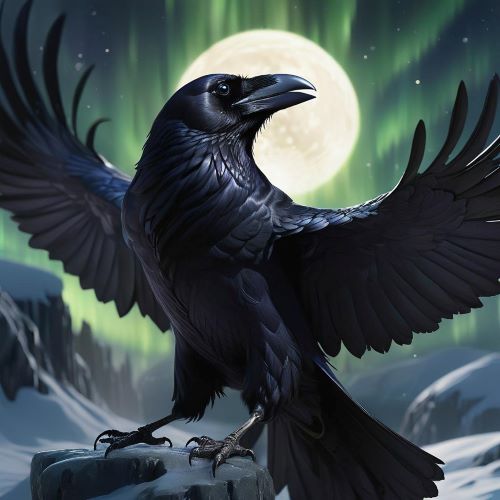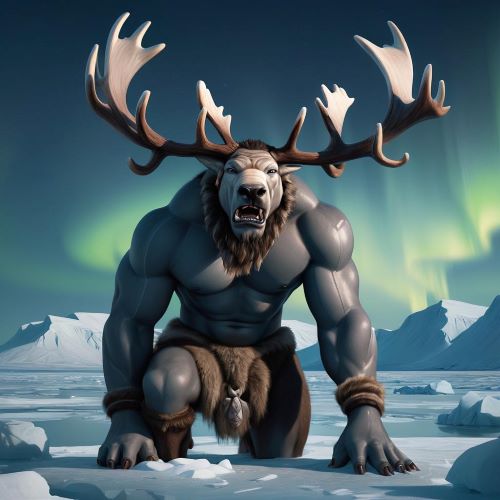Issitoq : All Seeing Eye
Listen
At a glance
| Description | |
|---|---|
| Origin | Inuit Mythology |
| Classification | Gods |
| Family Members | N/A |
| Region | Canada, Greenland |
| Associated With | Enforcing Laws |
Issitoq
Introduction
Issitoq, also referred to as Isitoq, is a captivating deity within Inuit mythology, embodying the role of enforcing social norms and punishing transgressors. Often depicted as a colossal flying eye, Issitoq symbolizes justice and order in Inuit culture. Unlike the familiar figures of powerful hunters or nurturing providers in other mythologies, Issitoq represents a necessary yet unsettling force—the guardian of societal harmony. The name Issitoq, meaning “he who sees all,” evokes a sense of unease among those familiar with Inuit lore, underscoring its role as a vigilant observer and enforcer of taboos.
Physical Traits
Issitoq’s appearance stands out starkly against the elaborate depictions of deities found in other mythologies—it is singularly represented as a colossal, disembodied eye. Picture an immense eyeball, unblinking and devoid of emotion, soaring through the Arctic skies. This giant eye is described as all-seeing, possessing the ability to penetrate the darkness and vast expanses of the Arctic landscape. Issitoq’s lack of a body underscores its role as a detached observer, akin to a cosmic surveillance camera ensuring adherence to the social and moral taboos vital for the survival of the Inuit people.
Another distinctive physical attribute of Issitoq is its massive, glowing eye, believed to oversee everything with unwavering vigilance. Additionally, Issitoq is depicted with formidable wings that enable it to navigate the air effortlessly. Despite its imposing size, Issitoq is reputedly agile and swift, capable of lightning-fast movements when required.
Family
Unlike the intricate family narratives often seen in other mythologies, Issitoq remains a solitary figure with no known origin story, siblings, or parental figures. This mysterious entity exists independently, serving as a vigilant guardian overseeing the vast Arctic expanses. The absence of familial ties emphasizes Issitoq’s impartiality as an enforcer, free from the biases that familial connections might entail. While believed to have been created by the gods to uphold laws and preserve order, the specifics of Issitoq’s lineage and familial relationships remain shrouded in mystery, lacking detailed documentation in available sources.
Other names
Commonly known as Issitoq, this deity is also identified as Isitoq in certain sources. These variations in naming reflect the linguistic and cultural diversity across Inuit communities. While Issitoq is the predominant appellation for this vigilant eye, regional variations exist. In some areas, he is recognized as Qailercetaq, the “watcher in the sky,” or Angakuaq, the “one who has a large forehead,” highlighting the significance of the singular, all-seeing eye. Despite these nuanced distinctions in names, all refer to the same entity—the omnipresent guardian of societal order. Each alternative name contributes to a multifaceted understanding of this mythological figure within Inuit lore.
Powers and Abilities
Issitoq is a formidable and formidable figure within Inuit mythology, embodying the role of a punishing deity with the ability to enforce strict taboos. Often represented as a colossal flying eye, Issitoq surveils the land and monitors all beings, capable of discerning thoughts and detecting wrongdoing with uncanny precision. When a taboo is breached, Issitoq descends swiftly from the skies to administer punishment, the extent of which remains somewhat mysterious.
Legends recount various forms of retribution inflicted by Issitoq upon transgressors, ranging from illness and misfortune to more severe consequences such as death or the disappearance of essential hunting grounds. This fear of Issitoq’s wrath served as a potent deterrent, ensuring societal cohesion among the Inuit. Additionally, there are tales of Issitoq rewarding those who uphold taboos with good fortune and successful hunts. Nevertheless, Issitoq’s primary role as an enforcer of order instills more fear than admiration within Inuit society, emphasizing the importance of adhering to societal norms and taboos to evade his vigilant gaze.
Modern Day Influence
Issitoq’s legacy endures in modern Inuit culture as a potent symbol of societal values and natural reverence. While not actively worshipped today, Issitoq’s name is invoked by elders as a cautionary reminder to younger generations about the importance of maintaining social order and showing respect for the environment. This mythical figure, represented as a giant flying eye in folklore, embodies the concept of a vigilant observer who ensures adherence to traditional taboos and communal norms. The ongoing use of Issitoq in oral traditions reflects its significance in preserving Inuit cultural values and teachings across generations.
Contemporary Inuit art frequently features depictions of Issitoq, serving as a visual reminder of the forces that have shaped Inuit society. Sculptures and paintings portraying the giant eye symbolize the enduring presence of Issitoq’s watchful gaze and the intrinsic connection between humans and their surroundings. Beyond its literal representation, Issitoq serves as a metaphorical embodiment of social consciousness, underscoring the necessity of maintaining harmonious relationships within the community and with nature.
In broader cultural contexts, Issitoq has captured the imagination of modern storytellers, finding its way into video games and literature as a compelling and sometimes unsettling character. This adaptation highlights Issitoq’s enduring appeal and the universal themes it represents, such as fear of the unknown and adherence to cultural taboos. By exploring Issitoq in contemporary narratives, creators pay homage to the rich heritage of Inuit mythology while also engaging audiences with timeless lessons about societal order and respect for traditional values. Ultimately, Issitoq’s cultural significance underscores the importance of honoring indigenous beliefs and preserving diverse mythological traditions in today’s globalized world.
Related Images
Frequently Asked Questions
What is lorem Ipsum?
I am text block. Click edit button to change this text. Lorem ipsum dolor sit amet, consectetur adipiscing elit. Ut elit tellus, luctus nec ullamcorper mattis, pulvinar dapibus leo.
What is lorem Ipsum?
I am text block. Click edit button to change this text. Lorem ipsum dolor sit amet, consectetur adipiscing elit. Ut elit tellus, luctus nec ullamcorper mattis, pulvinar dapibus leo.
What is lorem Ipsum?
I am text block. Click edit button to change this text. Lorem ipsum dolor sit amet, consectetur adipiscing elit. Ut elit tellus, luctus nec ullamcorper mattis, pulvinar dapibus leo.
What is lorem Ipsum?
I am text block. Click edit button to change this text. Lorem ipsum dolor sit amet, consectetur adipiscing elit. Ut elit tellus, luctus nec ullamcorper mattis, pulvinar dapibus leo.
What is lorem Ipsum?
I am text block. Click edit button to change this text. Lorem ipsum dolor sit amet, consectetur adipiscing elit. Ut elit tellus, luctus nec ullamcorper mattis, pulvinar dapibus leo.












